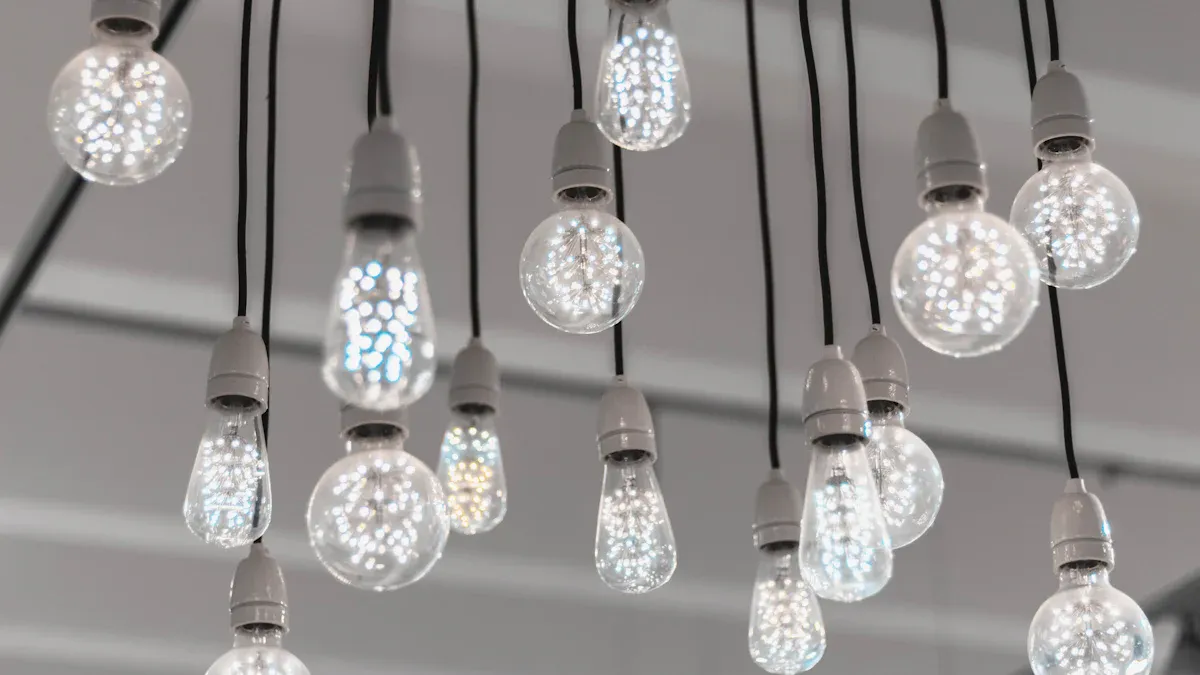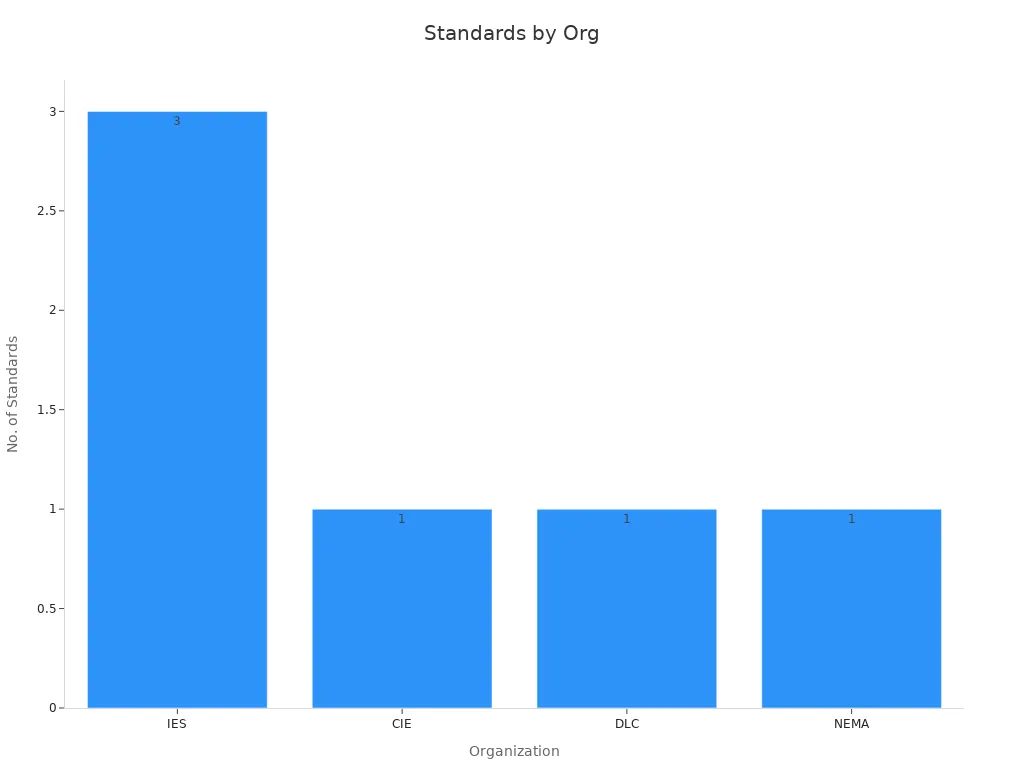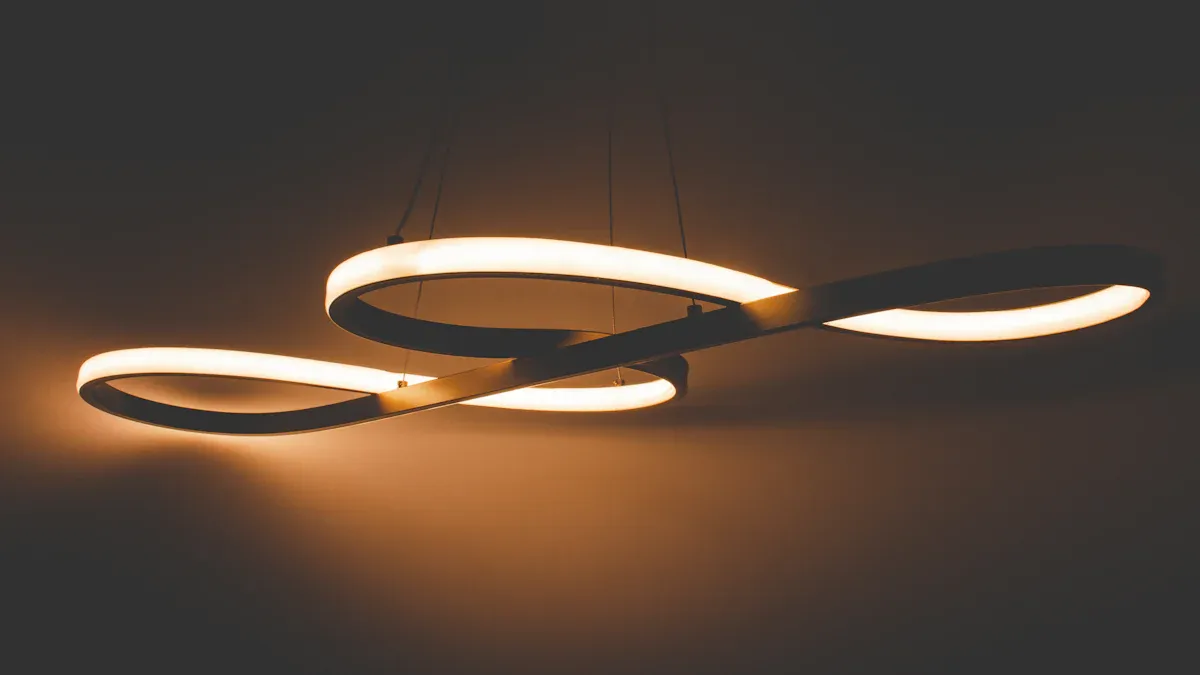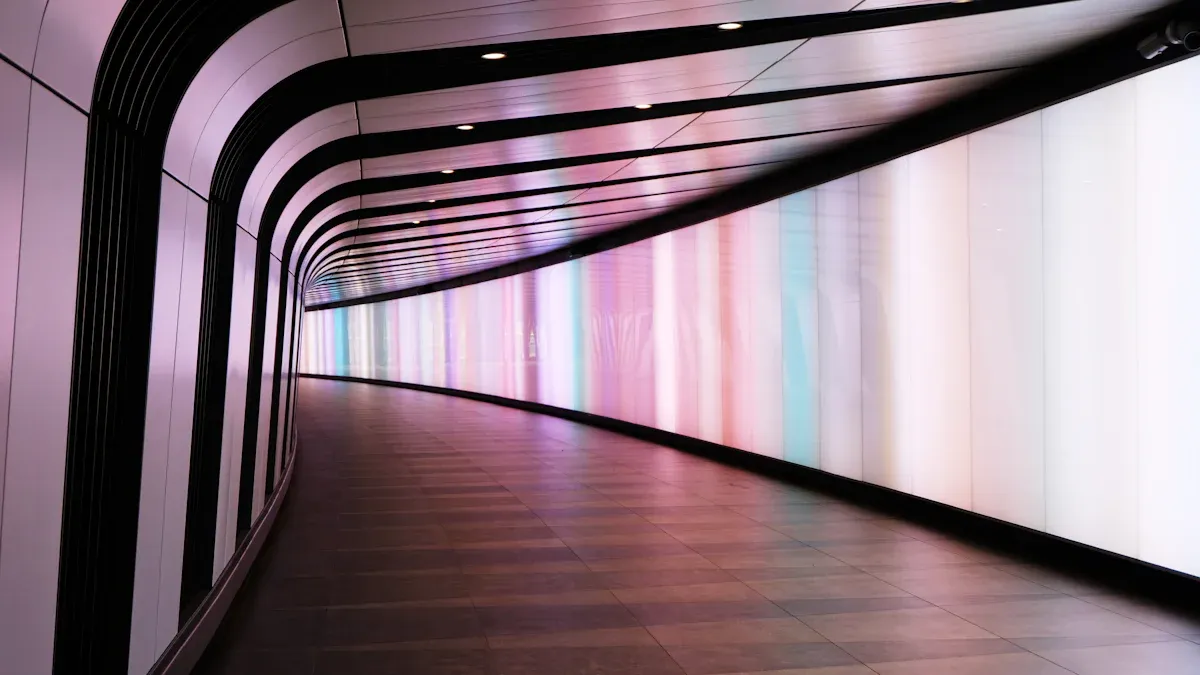LED Lighting Resources for Professional Lighting Design

LED lighting resources play a key role in successful architectural lighting design. Professionals rely on a variety of tools, including online platforms, standards, product information, educational materials, publications, and communities. By using these led lighting resources, they improve planning, efficiency, and light quality. Recent advances show that LEDs now achieve up to 220 lumens per watt, last 25 times longer than older bulbs, and use 75% less energy. These improvements help lighting professionals create safe, efficient, and attractive spaces. Integrating led lighting resources into daily planning and architectural projects leads to better outcomes and supports long-term growth. Readers can find valuable information on Home, About Us, Product, and Led Light platforms to expand their knowledge of light and architectural applications.
Key Takeaways
Use online tools and calculators to plan LED lighting projects efficiently and reduce errors.
Follow lighting standards from IES, CIE, and DLC to ensure safety, energy savings, and quality.
Access product databases, specification platforms, and manufacturer portals for accurate LED product information.
Keep learning through courses, webinars, and events to stay updated on new LED technologies and best practices.
Join professional communities and forums to share knowledge, solve problems, and grow your lighting design skills.
LED Lighting Resources
Online Tools
Online tools have become essential for professionals working with LED lighting. These platforms help users plan, analyze, and specify lighting for many types of projects. Lightology, Texas Instruments, and Take Three Lighting offer some of the most popular online tools in the industry. Each platform provides unique features that support the design process.
Tip: Online tools can save time and reduce errors during the planning stage of a lighting project.
Many online LED lighting design tools now include features such as mobile energy audits, cloud data synchronization, and access to large product catalogs. Retrolux, Streamlinx, EcoInsight, and OptoMizer allow users to collaborate with team members, build project estimates, and track rebates. These tools often provide customizable reporting, which helps professionals present their findings to clients or stakeholders. Pricing models for these tools vary, with some offering free versions and others using subscription plans.
The global smart LED lighting market continues to grow. In 2024, the market reached $27.32 billion. Experts expect it to grow even more as governments focus on sustainable lighting and smart homes become more popular. This growth shows that more professionals are using online tools to improve their lighting designs.
Calculators
Calculators play a key role in LED lighting design. They help professionals perform photometric analysis, energy calculations, and product comparisons. Lightology and Texas Instruments both provide calculators that make it easy to estimate light levels, energy savings, and fixture requirements.
Take Three Lighting offers calculators that help users select the right LED products for each application. These calculators can compare the performance of different LEDs used in lighting, making it easier to choose the best option for each project. Professionals use these tools to ensure that their designs meet both client needs and industry standards.
The following table shows some common LED lighting product types and related online resources:
LED Lighting Product Types and Features | Description and Examples |
|---|---|
Replacement Bulbs | LED alternatives for 40W, 60W, 75W, 100W incandescent bulbs |
Specialty Bulbs | Reflector bulbs for recessed fixtures, track lights, task lighting, undercabinet lighting |
Outdoor Lighting | Pathway lights, step lights, porch lights, solar-powered outdoor LEDs |
Features | Color tuning, dimmability, daylight and motion sensors, durability in cold and outdoor environments |
Related Online Resources and Standards | Purpose |
|---|---|
Lighting Facts Label | Standardized product information on lumens and energy use |
Lighting Principles and Terms | Definitions and concepts for lighting design |
LED Lighting | General LED lighting information and guidance |
Outdoor Solar Lighting | Information on solar-powered LED outdoor lighting |
Guidance on upgrading to LED products | |
Lighting Design | Principles and best practices for lighting design |
Lighting Controls | Information on lighting control technologies |
Daylighting | Use of natural light in design |
Lighting and Daylighting Products and Services | Product databases and service resources |
Professionals rely on these calculators and online tools to make informed decisions. They use them to check light levels, compare products, and calculate energy savings. These resources help ensure that every lighting project meets high standards for quality and efficiency.
Standards and Guidelines
Lighting professionals depend on clear standards and guidelines to ensure quality, safety, and efficiency in every project. These standards help designers meet energy codes and deliver consistent results. Lightology provides a helpful overview of energy codes and industry standards, making it easier for professionals to stay updated.
IES
The Illuminating Engineering Society (IES) sets many of the most recognized lighting standards in North America. IES publishes documents like ANSI/IES TM-39-25, which explains how to measure flicker in lighting, and ANSI/IES RP-8-25, which covers best practices for roadway and parking lighting. These documents help designers create safe and energy-efficient outdoor spaces. IES also offers ANSI/IES LS-5-25, a guide to color science in lighting. Designers use these resources to select products and plan layouts that meet both client needs and energy requirements.
CIE
The International Commission on Illumination (CIE) develops global standards for lighting and color. CIE 255:2025 reviews how people see and respond to light, which is important for setting safe and comfortable lighting levels. Many countries use CIE guidelines to shape their own energy codes. Designers often refer to CIE standards when working on international projects or when they need to meet strict visual performance goals.
DLC
The DesignLights Consortium (DLC) focuses on energy efficiency and lighting controls. DLC works with groups like NEMA to create standards such as ANSI/NEMA C137.9-2025, which covers networked lighting control systems. These standards help ensure that lighting systems save energy and work well with other building technologies. DLC also supports outdoor lighting resilience through standards like ANSI C137.10.
Note: Designers can access these standards through the official websites of IES, CIE, and DLC. Lightology’s resource center also provides links and summaries for many key documents.
The following table compares important standards from IES, CIE, and DLC:
Organization | Standard/Report | Description | Relevance to Lighting Design |
|---|---|---|---|
IES | ANSI/IES TM-39-25 | Flicker quantification and specification | Supports updated metrics for lighting and energy codes |
IES | ANSI/IES RP-8-25 | Roadway and parking lighting practices | Validates outdoor lighting design and energy standards |
IES | ANSI/IES LS-5-25 | Color science in lighting | Enhances energy-efficient design with color guidance |
CIE | CIE 255:2025 | Functional visual field studies | Advances understanding of visual perception for energy codes |
DLC | ANSI/NEMA C137.9-2025 | Networked lighting control systems | Streamlines energy-efficient lighting practices |
NEMA (with DLC input) | ANSI C137.10 | Outdoor lighting resilience and interoperability | Aligns with energy codes and resilience requirements |

Designers often validate their work by measuring real-world lighting performance. For example, Lightology and other manufacturers have tested LED lighting in different settings. The table below shows how these standards apply in practice:
Device/Setting | Measured Illuminance (lux) | Measured Circadian Stimulus (CS) | Compliance/Standards Reference |
|---|---|---|---|
Light Tables (XtraLight) | 0.625 | CIE alpha-opic values | |
Light Trays (LHRC) | 602 lx (active), 65 lx (control) | 0.456 (active), 0.064 (control) | CIE alpha-opic values |
Ambient Room Lighting | 520 lx (intervention), 135 lx (control) | 0.37 (intervention), 0.1 (control) | Confirmed by spectroradiometer; programmable CS schedule |
These results show that following standards from IES, CIE, and DLC leads to lighting designs that meet both energy codes and human needs. Professionals who use these guidelines can deliver projects that save energy and improve comfort.
LED Lighting Products

Selecting the right LED lighting products is a critical step in any architectural or commercial lighting project. Professionals depend on accurate, current information to compare options, plan installations, and ensure long-term performance. The market for LED lighting continues to expand, with new features and technologies appearing every year. Reliable resources help designers and facility managers make informed decisions that support both energy efficiency and visual comfort.
Product Databases
Product databases serve as the foundation for effective lighting planning. These platforms collect detailed specifications for thousands of LED lighting products, including light fixtures, dedicated LED light fixtures, and LED bulb solutions. PROLIGHTING and Alcon Lighting offer comprehensive catalogs that allow users to filter by application, wattage, color temperature, and certification. These databases support both residential and commercial projects, helping users find energy star certified light fixtures and products with long lifetime ratings.
Residential consumers often choose LED lighting for energy savings and smart control features.
Commercial buildings require detailed product data to customize lighting environments and reduce costs.
Outdoor lighting, such as streetlights and parking lot fixtures, increasingly uses LED technology for better illumination and efficiency.
A well-maintained product database provides up-to-date information on the useful life of LED lighting, installation requirements, and warranty terms. This data helps professionals select fixtures that meet project goals and comply with regulatory standards. As the variety of LED lighting products grows, the need for accurate, accessible databases becomes even more important.
Specification Platforms
Specification platforms streamline the process of selecting and documenting LED lighting products for architectural and commercial projects. LED There B Light and Unique Lighting offer tools that allow users to compare technical details, download specification sheets, and generate submittal packages for approval. These platforms often include advanced search features, making it easy to find dedicated LED light fixtures with specific lumen outputs, color rendering, or smart controls.
Online sales channels provide extensive catalogs, installation guides, and energy savings calculators.
Manufacturers add features like Wi-Fi connectivity and sensors, increasing product complexity and the need for detailed specification data.
Specification platforms help lighting professionals ensure that selected fixtures meet both design intent and code requirements. They also support planning for lighting installation by providing clear instructions and compatibility information. With the shift toward smart, connected lighting in commercial and residential markets, these platforms play a vital role in project success.
Manufacturer Portals
Manufacturer portals give direct access to the latest LED lighting products, technical documents, and support resources. Leading brands update their portals frequently, offering detailed information on light fixtures, installation procedures, and performance data. These portals often include tools for estimating the lifetime of LED lighting products and comparing different models for commercial lighting applications.
Regulatory standards from organizations like ANSI and IEC require certification and quality assurance.
Manufacturer portals help professionals verify compliance and select products with proven performance.
The integration of LED lighting with smart home and IoT systems increases the need for reliable, up-to-date product information.
Professionals use manufacturer portals to download installation guides, review warranty policies, and access support for lighting installation. These resources ensure that every fixture meets project requirements and delivers the expected lifetime and performance. By staying current with manufacturer updates, designers and facility managers can maximize the value and longevity of their lighting investments.
Tip: Always check the manufacturer portal for the latest product updates and installation instructions before finalizing your lighting plan.
A comparison of key resources for LED lighting product selection:
Resource Type | Example Platforms | Key Features | Application Areas |
|---|---|---|---|
Product Databases | PROLIGHTING, Alcon Lighting | Searchable catalogs, filter by specs, warranty info | Residential, Commercial, Outdoor |
Specification Platforms | LED There B Light, Unique Lighting | Spec sheet downloads, comparison tools, submittal packages | Architectural, Commercial |
Manufacturer Portals | Major LED brands | Technical docs, installation guides, compliance info | All project types |
The lifetime of LED lighting products depends on proper selection, installation, and maintenance. Up-to-date product information supports better planning and ensures that light fixtures deliver reliable performance throughout their useful life. As the LED lighting market evolves, professionals who use these resources gain a clear advantage in delivering high-quality, energy-efficient lighting solutions.
Education and Training

Lighting professionals need to keep their skills sharp as technology changes. Education and training resources help them stay current with new products, standards, and best practices. Many respected organizations offer courses, webinars, and events that support ongoing learning in LED lighting.
Courses
Courses provide structured learning for both beginners and experienced designers. Signify Lighting Academy offers a wide range of online and in-person courses. These cover topics such as lighting design, energy efficiency, and smart lighting controls. SMUD and Crown Lighting Group also provide specialized training. Their programs focus on practical skills like fixture selection, installation, and lighting controls. Many courses offer Continuing Education Units (CEUs) from groups like AIA and USGBC. This helps professionals meet certification requirements and advance their careers.
Lighting courses often include hands-on activities and real-world case studies. This approach helps learners apply new knowledge directly to their projects.
Webinars
Webinars give professionals access to expert insights without leaving their office. Cooper Lighting’s The Lighting reSOURCE and the Illuminating Engineering Society (IES) host regular webinars on topics such as sustainability, lighting life cycle, and human health impacts. These sessions often feature live Q&A with industry leaders. Many webinars offer discounts on related courses or free access to recorded sessions. This makes it easy for busy professionals to keep learning.
Recent trends show that webinars play a key role in professional development. Experts from the Department of Energy and Pacific Northwest National Lab highlight the value of webinars in fields like healthcare lighting. These sessions help professionals understand how lighting affects safety and performance in specialized environments.
Events
Events bring lighting professionals together to share ideas and learn about new trends. Conferences, workshops, and trade shows offer hands-on demonstrations and networking opportunities. The Lutron Lighting Control Institute (LCI) and other groups host events that cover the latest technologies and best practices. Attendees can earn CEUs and gain practical skills in designing, selling, and installing LED lighting systems.
Events support continuous learning and help professionals stay ahead in a fast-changing industry.
Networking at events often leads to new partnerships and project opportunities.
Ongoing education ensures that lighting professionals deliver safe, efficient, and innovative solutions for every project.
Publications and Research
Staying informed about the latest trends and research is essential for anyone involved in lighting design. Publications and research platforms provide valuable insights into new products, technology, and best practices. These resources help professionals improve light quality, extend the lifetime of installations, and boost overall project performance.
Journals
Industry journals deliver in-depth technical articles and research findings. LED professional stands out as a leading source for solid-state lighting technology updates. This journal covers topics such as light output, energy efficiency, and new materials. Many journals publish peer-reviewed studies that examine how different light sources affect visual comfort and the lifetime of fixtures. Professionals use these findings to select products and design systems that meet strict standards.
Magazines
Magazines like BUILDINGS Magazine, Retrofit, and Arc Magazine offer a broader view of the lighting industry. They feature product reviews, market analysis, and renovation advice. These magazines reach a wide audience, including lighting designers, engineers, and facility managers. Regular updates keep readers aware of new light technologies and design trends. Magazines often highlight case studies that show how LED solutions improve light quality and extend the lifetime of lighting systems.
Research Portals
Research portals collect and share the latest information on lighting technology. Cooper Lighting’s The Lighting reSOURCE and government sites like the Office of Energy Efficiency and Renewable Energy (EERE) provide technical assistance and market-driven solutions. These portals support innovation by offering access to archives, technical reports, and event coverage. Professionals rely on these platforms to stay current with advances in LED lighting and to find guidance on improving light installations.
Many publications and portals update their content weekly or even daily.
They cover a range of topics, from product showcases to market intelligence.
Their archives help professionals track changes in light technology and design practices over time.
Following respected journals, magazines, and research portals ensures that lighting professionals stay ahead in a fast-changing field. These resources support better light design, longer lifetime for fixtures, and improved project outcomes.
Professional Communities
Lighting professionals benefit from strong communities that support knowledge sharing and career growth. These communities help individuals stay updated on the latest trends in commercial lighting, fixtures, and installation practices. They also provide a space for discussing challenges and solutions in lighting installation and commercial projects.
Forums
Online forums create a space for lighting experts and newcomers to ask questions and share experiences. Users discuss topics such as selecting fixtures, troubleshooting installation issues, and optimizing commercial lighting systems. Popular forums include The Light Board and Reddit’s r/lighting. These platforms allow members to post photos, share advice, and learn from real-world projects. Many users find answers to technical questions about commercial fixtures and lighting installation.
Tip: Forums often feature “sticky” posts with guides on common commercial lighting problems.
Associations
Industry associations set standards and offer resources for lighting professionals. Groups like the Illuminating Engineering Society (IES) and the International Association of Lighting Designers (IALD) provide access to research, training, and certification. Members receive updates on new fixtures, commercial codes, and best practices for installation. Associations also host events and webinars that connect professionals from different commercial sectors.
Association | Key Benefits | Membership Perks |
|---|---|---|
IES | Standards, research | Training, publications |
IALD | Design focus | Networking, events |
NALMCO | Maintenance, installation | Certification, resources |
Peer Support
Peer support networks help lighting professionals solve problems and grow their skills. Resource centers like Signify’s Specifier Hub offer tools, case studies, and direct support for commercial projects. Members can connect with peers to discuss fixture selection, installation tips, and new lighting technologies. Peer groups often organize local meetups or online chats to share updates on commercial lighting trends.
Joining a peer network can lead to faster solutions and better project outcomes.
Professionals who use led lighting resources gain a clear advantage in design. These resources—ranging from online tools to product databases and professional communities—support better project outcomes and continuous improvement.
The market for LED lighting grows at over 10% each year, driven by efficiency, smart controls, and long lifespan.
Advanced smart systems and ongoing research drive new applications and higher performance.
Economic and environmental benefits motivate designers to keep learning and adopting new led lighting resources.
Statistic | Value/Insight |
|---|---|
25,000–50,000 hours | |
Price Drop Since 2010 | Over 90% |
Market Share (Commercial) | 51.9% |
Staying proactive with new tools and education ensures lasting success in lighting design.
FAQ
What are the most important online tools for LED lighting design?
Professionals use platforms like Lightology, Texas Instruments, and Take Three Lighting. These tools help with planning, photometric analysis, and energy calculations. They improve accuracy and save time during project development.
How do lighting standards impact project outcomes?
Lighting standards from IES, CIE, and DLC set clear guidelines for safety, efficiency, and quality. Designers follow these standards to meet codes and deliver consistent results in every project.
Where can professionals find reliable LED product information?
Product databases such as PROLIGHTING and Alcon Lighting provide up-to-date specifications. Manufacturer portals offer technical documents, installation guides, and warranty details for accurate product selection.
Why is ongoing education important in lighting design?
Ongoing education helps professionals stay current with new technologies and best practices. Courses, webinars, and events from groups like Signify Lighting Academy and Cooper Lighting support skill development and career growth.
How do professional communities support lighting designers?
Professional communities offer forums, associations, and peer networks. These groups share knowledge, answer questions, and provide networking opportunities. Members gain access to industry updates and practical advice.
See Also
Comprehensive Guide To Track LED Lighting Systems And Design
Effective Lighting Strategies For Retail Spaces And Stores
Optimizing Commercial Lighting Solutions For Business Environments
Choosing The Right LED Industrial Lighting Benefits And Uses

